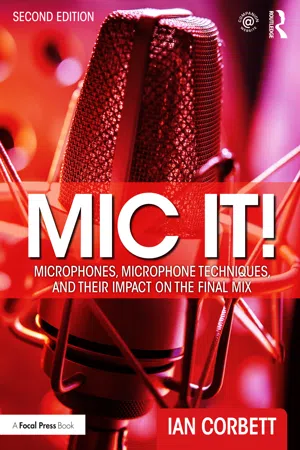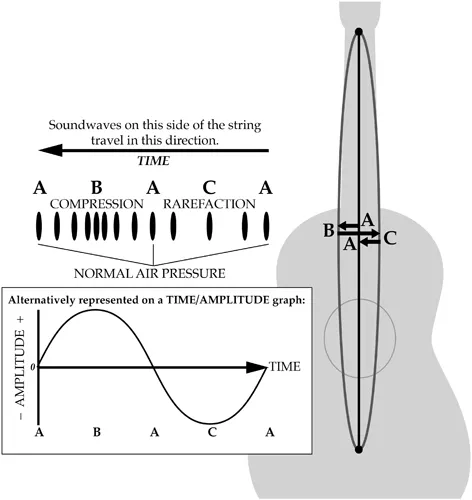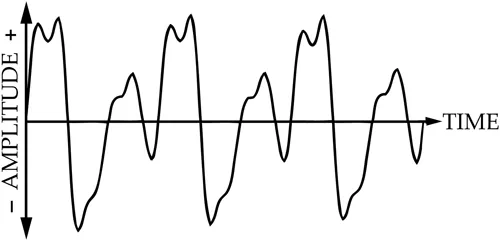
Mic It!
Microphones, Microphone Techniques, and Their Impact on the Final Mix
- 424 pages
- English
- ePUB (mobile friendly)
- Available on iOS & Android
About this book
Capture great sound in the first place and spend less time "fixing it in the mix" with Ian Corbett's Mic It! With this updated and expanded second edition, you'll quickly understand essential audio concepts as they relate to microphones and mic techniques and learn how to apply them to your recording situation. Mic It! gives you the background to explore, discover, and design your own solutions, enabling you to record great source tracks that can be developed into anything from ultra-clean mixes to massive, organic soundscapes.
Beginning with essential audio theory and a discussion of the desirable characteristics of "good sound", Mic It! covers microphones, mono and stereo mic techniques, the effect of the recording space or room, and large classical and jazz ensemble recording. This second edition also features new chapters on immersive audio, immersive recording concepts, drum tuning, and recording techniques for audio for video. Mic It! provides in-depth information on how different mic techniques can be used, modified, and fine-tuned to capture not only the best sound, but the best sound for the mix, as well as how to approach and set up the recording session, prepare for mixing, and avoid common recording and mixing mistakes.
• Train your ears with practical audio examples on the companion website.
• Develop and test your knowledge as you learn, with concise, applicable exercises and examples that cover the concepts presented.
• Record the best sound possible in any situation with Mic It!
Corbett's expert advice ranges from vital knowledge no novice should be without, to advanced techniques that more experienced engineers can explore to benefit and vary the sound of their recordings. Whether you only ever buy one microphone, are equipping a studio on a budget, or have a vast selection of great mics to use, with Mic It! you'll learn how to make the most of the tools you have.
Frequently asked questions
- Essential is ideal for learners and professionals who enjoy exploring a wide range of subjects. Access the Essential Library with 800,000+ trusted titles and best-sellers across business, personal growth, and the humanities. Includes unlimited reading time and Standard Read Aloud voice.
- Complete: Perfect for advanced learners and researchers needing full, unrestricted access. Unlock 1.4M+ books across hundreds of subjects, including academic and specialized titles. The Complete Plan also includes advanced features like Premium Read Aloud and Research Assistant.
Please note we cannot support devices running on iOS 13 and Android 7 or earlier. Learn more about using the app.
Information
1 Audio Basics
In This Chapter:
- 1.1 It’s Not Always About the Gear!
- 1.2 What is Sound?
- 1.3 The Decibel (dB)
- 1.4 Power Relationships
- 1.5 Decibel Scales
- 1.6 Dynamic Range
- 1.7 Signal-to-Noise Ratio
- 1.8 Frequency vs Pitch
- 1.9 Frequency Response
- 1.10 Waveforms, Fundamentals, and Harmonics
- 1.11 Wavelength, Velocity, Phase
- 1.12 Amplitude Summation and Comb Filtering
- 1.13 Human Hearing
- 1.14 Signal Flow and Audio Level Standards
- 1.15 Gain Structure and Recording Levels
- 1.16 Analog Audio Connectors
- 1.17 Digital Audio Connectors
- 1.18 Digital Audio Basics
An engineer who knows how to use a mic is more important than the mic.–Wes Maebe, Engineer/Producer: Sonic Cuisine, RAK Studios, London, UK
The best microphone I’ve used in my life was the one that was up when the artist did something great.–Joel Hamilton, Producer, Engineer, Co-Owner: Studio G Brooklyn, New York, USA
1.1 It’s Not Always About the Gear!
1.2 What is Sound?

- Increases as air temperature rises, and decreases as air temperature falls.
- Decreases slightly as altitude increases (though this has more to do with the altitude-associated temperature decrease than the change in air pressure).
- Increases a little as humidity rises.

1.3 The Decibel (dB)
Table of contents
- Cover
- Half-Title
- Title
- Copyright
- Contents
- About the Author
- Acknowledgments
- 1 Audio Basics
- 2 “Good Sound”
- 3 About Microphones, Part 1…
- 4 About Microphones, Part 2…
- 5 EQ Basics
- 6 Stereo Imaging
- 7 Stereo Microphone Arrays
- 8 Immersive Audio
- 9 The Effect of Microphone Position
- 10 The Recording Room
- 11 Recording Vocals
- 12 Drum Miking
- 13 Drum Tuning
- 14 Guitars, Basses, and Keyboards
- 15 Strings, Winds, Brass, and Percussion
- 16 Setting Up the Studio
- 17 Miking Large Ensembles
- 18 Putting It All Together
- 19 Audio for Video
- 20 Tips From the Professionals…
- Index